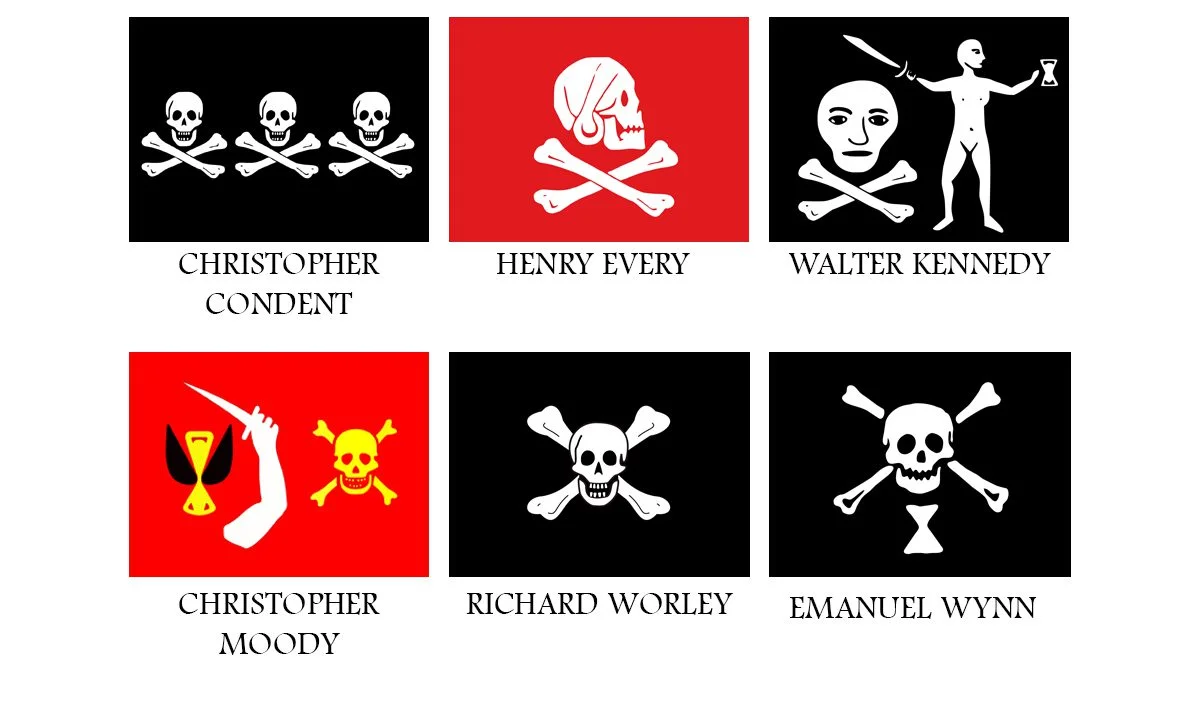Flags are mainly used as international symbols to represent a people or a nation, or for nautical and aerial communication.
This was no different during the latter part of the Golden Age of Piracy, where flags, commonly referred to as the ‘Jolly Roger’, would be raised to identify a ship or individual.
During the Golden Age around the 1650s and the 1730s, piracy was subdivided into three periods:
The Buccaneering Period, a time when French seamen attacked Spanish colonies and shipping in the Caribbean and eastern Pacific.
The Pirate Round, consisting of mainly English pirates who targeted Muslim and East India Company shipping in the Indian Ocean and the Red Sea.
The Post-Spanish Succession Period, when Anglo-American sailors and privateers left unemployed by the end of the War of the Spanish Succession turned to piracy in the Caribbean, the Indian Ocean, the North American eastern seaboard, and the West African coast.

One of the earliest descriptions of pirate flags can be found in ‘A General History of the Robberies and Murders of the most notorious Pyrates’, published in 1724 and written by a Captain Charles Johnson, whose identity has been the subject of scholarly debate.
Some historians suggest that the author may have been Daniel Defoe who wrote the novel Robinson Crusoe, or Nathaniel Mist, a British printer and journalist who is credited with writing the anti-whig ‘Mist’s Weekly Journal’.
The book gives a mythical status to the lives and exploits of infamous pirates such as: Charles Vane, Edward Teach (Blackbeard), Calico Jack Rackham, Anne Bonny, Mary Read, William Kid, Edward Ned Low, Henry Every and Philip Roche.
The General History also introduces readers to many features of piracy that became common in associated literature and legend, such as the notion of pirates burying treasure, and the name of the pirate flag being called the ‘Jolly Roger’ by the Welsh pirate Bartholomew Roberts and the English pirate Francis Spriggs.

Whilst both captains may have used the same name for their flags, the flag designs were very different, suggesting that the name was a generic term for black pirate flags rather than a name for any specific flag design.
Another reference of ‘Old Roger’ can be found in a news report from 1723 in the Weekly Journal or British Gazetteer, describing: “Their black Flag, under which they had committed abundance of Pyracies and Murders, was affix’d to one Corner of the Gallows. It had in it the Portraiture of Death, with an Hour-Glass in one Hand, and a Dart in the other, striking into a Heart, and three Drops of Blood delineated as falling from it. This Flag they called Old Roger, and us’d to say, they would live and die under it.”
One of the most associated designs to the Jolly Roger is the skull-and-crossbones symbol that has become synonymous with modern depictions of pirates in literature and films.
The design may have originated from the Muslim Black Standard used by Barbary pirates who operated from North Africa (although contemporary accounts refer to the symbol mainly being shown on a green flag), whilst another early account can be found in the 1687 ‘Bibliothèque nationale de France’, which records a skull-and-crossbones design being used on a red flag by pirates on land.

Another early use of the design is documented in the British Admiralty Records of 1700, where the frigate, HMS Poole, engaged a pirate ship commanded by Captain Emanuel Wynn which flew a Jolly Roger described as: “a sable flag with a white death’s head and crossed bones in the fly”, generally considered by many historians to be the first definitive skull-and-crossbones pirate flag.
By the end of the War of the Spanish Succession in 1714, many privateers turned to piracy and decorated their flags with their own designs and variations of the Jolly Roger (some adopting a mix of colours) to identify themselves or communicate at sea.
Pirate ships would normally fly a false flag or sail without colours until they had their prey within firing range. They then raised the Jolly Roger, often simultaneously with a warning shot, which may have given target ships an opportunity to decide to surrender without a fight.
Flying a Jolly Roger was a reliable way of proving oneself a pirate, only a pirate would dare fly the Jolly Roger, as he was already under threat of execution if caught.
Header Image Credit : Shutterstock





